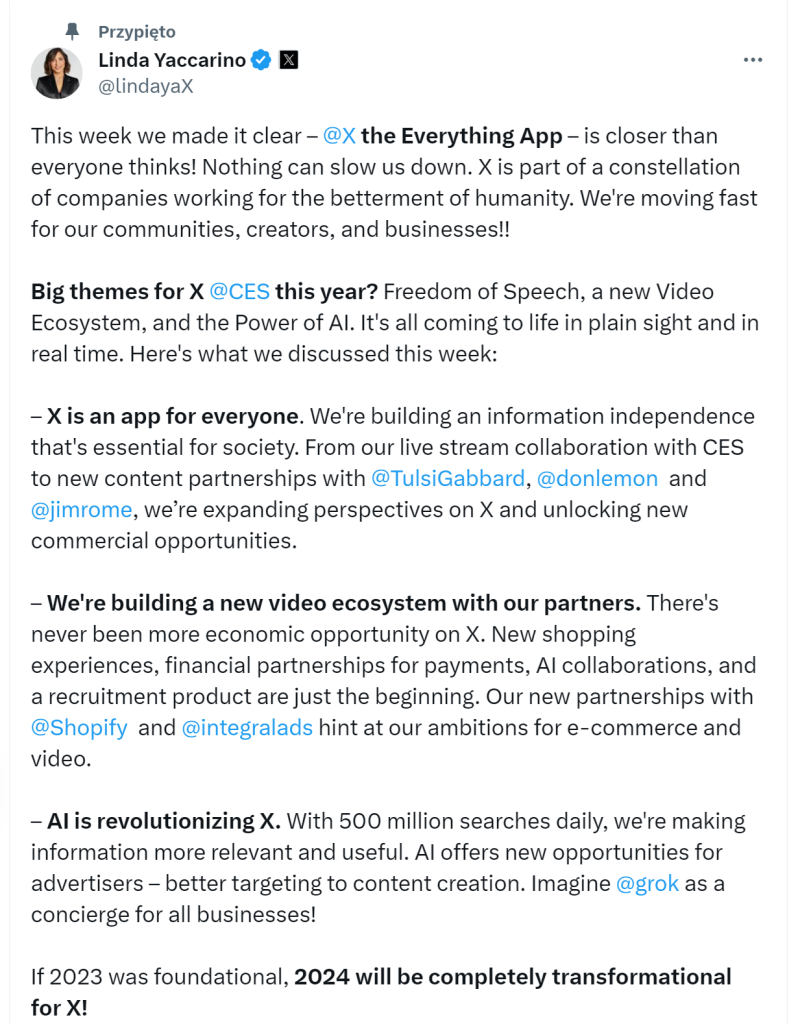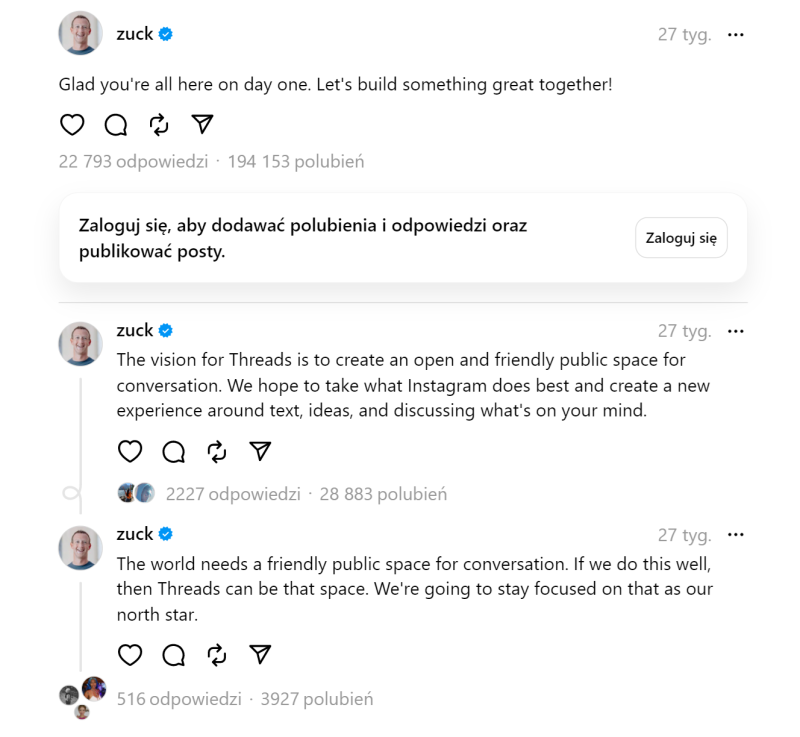Threads vs Twitter (X) - table of contents
Since July 6, 2023, when Meta introduced Threads, internet users have been pondering its use and viability. It’s hard not to notice the resemblance to the well-known Twitter app, currently X. Which platform should you choose in 2024? Let’s delve into the Threads vs Twitter (X) battle for attracting and retaining users, as well as market dominance.
Twitter, currently X. What changes has Elon Musk introduced to the service?
On October 28, 2022, Elon Musk officially finalized the acquisition of Twitter, paying around $44 billion for the platform. The new owner announced this on his profile with a short tweet saying “the bird is freed,” referring to Twitter’s logo, depicting a white bird on a blue background.
After acquiring Twitter (X), Elon Musk decided to lay off nearly 80% of employees, including Twitter CEO Parag Agrawal, Chief Legal Officer Vijaya Gadde, and Chief Financial Officer Ned Segal.
The billionaire’s next steps were to rename the app from Twitter to X, replace the existing logo with a black and white “X,” and introduce optional paid subscriptions. X Premium offers additional features depending on the subscription chosen. There are three options:
- Basic Tier – $3/month or $32/year,
- Premium Tier – $8/month or $84/year,
- Premium+ Tier – $16/month or $168/year.
The prices of individual subscriptions may vary depending on the country. The full list of features and pricing is available on the X Help Center website.
Is it worth upgrading to the paid version of Twitter (X)? It depends on your needs. If you want to post longer tweets, share extended videos, or create communities with people of similar interests, the paid version is necessary. If you use the app occasionally, the free version should be enough.
Is Elon Musk striving to develop a super app?
Why did Elon Musk change the name of Twitter to X? Industry experts speculate that this is a step towards developing the super app and unveiling new features. After all, since taking over, Musk has promised a number of changes to the platform, which he is gradually working to implement.
The term “super app” refers to a mobile or web application that, apart from a set of basic functions, provides access to independent mini- or micro-applications. A current example of the super app is WeChat, a Chinese social networking and instant messaging service that also offers banking or shopping features. WeChat is a multifunctional tool that can be used to pay bills, make purchases, buy tickets, or order taxis.
With super apps, users don’t have to install lots of different apps on their devices. They can find all the features and services they need in one place. This also benefits businesses, who can reach new and existing customers quickly and easily.
Not surprisingly, Elon Musk’s goal is to make Twitter (X) a super-app. These plans were also confirmed by the current CEO of Twitter (X), Linda Yaccarino, who wrote on her profile on January 12, 2024, “the Everything App – is closer than everyone thinks!”

Source: https://twitter.com/lindayaX/status/1745614699440533658
Threads. A new player on the market
Threads premiered in July of the previous year, yet it wasn’t until December 14, 2023, that the app became accessible in the European Union. Delays were attributed to the service violating several provisions of the EU Digital Markets Act. Meta, however, swiftly adapted to comply with EU regulations, successfully launching its new product in the European market. Mark Zuckerberg reported that within a mere seven hours of its debut, approximately 10 million users had already logged into the application.
The visionary behind Meta, Mark Zuckerberg, shares that Threads was created to foster a welcoming and open environment for conversations. Despite Zuckerberg’s use of Twitter (X) and recognition of its potential, he observed a concerning shift in the platform’s development, with an increasing focus on spreading misinformation, propaganda, and hate speech.
The controversies surrounding X stem from hurried and chaotic changes, Elon Musk’s forceful imposition of his vision on other company employees, and a surge in fake accounts disseminating false and unscientific information. In response to these challenges, Mark Zuckerberg crafted an alternative platform designed to evoke a sense of warmth and authenticity among users.

Source: https://www.threads.net/@zuck/post/CuVYy5Fvrrd/?igshid=NTc4MTIwNjQ2YQ==
Threads is powered by Instagram. This means that a profile created on Threads is linked to the logged-in Instagram account, allowing for a quick import of information and followers. The platform offers similar functionalities to X, formerly known as Twitter. Users can, among others:
- publish and edit content (up to 500 characters),
- search for posts and profiles of other people,
- build upon ongoing conversations,
- repost, cite, and like threads,
- share videos, photos, GIFs, and links,
- change profile settings to private or public,
- add polls to their posts,
- post voice notes, which are automatically converted to text.
Threads – first user reviews
On the Internet, you can find numerous publications regarding Threads. Marketing experts eagerly share their thoughts and concerns about the new service. Primarily, they question whether, in an era of information overload, Threads will gain traction in the market. While opinions are divided, it’s worth noting that without demand, there would be no supply. As indicated by statistics, interest in Threads is steadily growing.
Industry experts underscore the notion that the mere act of setting up an account adds minimal value. As is the case with any platform, crafting a thoughtful strategy, consistently producing engaging content, experimenting with various formats, and staying vigilant to evolving trends are crucial elements for success.
Threads vs Twitter (X). Selecting the ideal platform for your company
Although Threads and Twitter (X) appear very similar in terms of design and functionality, using both applications reveals significant differences, primarily stemming from the user base and discussed topics.
Twitter (X) primarily attracts individuals from the world of politics and business, including journalists and politicians. The majority of users are men (approximately 73%), and people in the age range of 25–34 form a significant portion of the user base. In terms of marketing activities, Twitter also holds a substantial advantage over Threads as it provides access to an advertising manager, with a potential advertising reach of over 500 million active users monthly.
Although Threads was launched in July 2023, the platform has already amassed over 140 million users, making it one of the fastest-growing applications globally. The user base on Threads is predominantly male, constituting approximately 68% of the total users. The dominant generation on the platform is Generation Z. Initial observations suggest that the posted content on Threads has a more relaxed theme compared to entries on Twitter (X). Many individuals are experimenting with content topics and attempting to decipher the algorithms at play.
Currently, marketers can’t create ads on Threads. However, there is a good chance that the platform will be integrated into Meta Ads Manager, thereby introducing new advertising formats and the ability to target ad sets to specific audiences. Influencers, particularly those active on Instagram, are enthusiastic users of Threads. Brands can collaborate with them to promote products/services on this new platform. Check out our article for tips on finding influencers for your campaign.
Using Threads in marketing has long-term potential. Currently, brands can focus on organic traffic by creating accounts to build and engage their community, sharing knowledge and experiences, and participating in discussions. Such a relationship, built on authenticity and trust, can yield better results in the future. While the intricacies of current algorithms are not fully understood, there seems to be a connection between the topics we engaged with on Instagram and the content suggested by Threads.
Twitter, currently X
| Many free and publicly accessible guides on managing a company profile and marketing on Twitter (X) | Paid subscriptions or a free account with numerous limitations |
| The availability of the X Ads Manager, allowing for the creation of advertisements | Changes regarding account verification and granting of the blue checkmark |
| The ability to communicate through private messages | In the free version, there are limitations on the length of posts (280 characters) |
| Quick access to current events — on the X platform (Twitter), content related to popular and ongoing events prevails, unlike Threads, where users share their thoughts | The increase in the number of fake accounts spreading misinformation and propaganda |
Threads
| Intuitive app — according to user opinions, the application is easier to use than X (Twitter) | Uncertainty whether the platform will gain traction in the market |
| The new platform is another opportunity to reach a broader audience, especially in the initial phase of the application’s development, where organic reach is more accessible | Creating an account on Threads requires having a profile on Instagram |
| A completely free application. In comparison to the free version of X, it offers the ability to publish longer posts (up to 500 characters) | No possibility to display ads or send private messages |
| Easy start — the ability to transfer followers from Instagram | A flood” of low-value posts, addressing the algorithm (e.g., “Algorithm, connect me with people who…”), instead of creating interesting content |
Threads vs Twitter. Summary
Threads or Twitter? The first of the two applications is currently a big unknown. It’s challenging to predict whether, after the initial interest in the new service, it will meet user expectations and sustain itself in the market. In the case of X (formerly Twitter), the situation is also dynamic. Elon Musk’s takeover of the platform, the introduction of numerous changes, including paid subscriptions, and the pursuit of creating a super app may both encourage and discourage users from using the service.
So, how should you plan your company’s actions? Which platform to choose? The answer to these questions will depend on the nature of the organization’s activities, its goals, and the available resources. Based on a subjective assessment of X (formerly Twitter), it will be a better fit for companies looking to track and comment on current events, with their target audience primarily being millennial men.
Threads, on the other hand, is recommended for companies looking to build long-term relationships, share their thoughts, engage in discussions, and cultivate the image of an authentic, transparent brand.
However, it’s worth closely monitoring the development of both applications and, if possible, testing them from within. Both Threads and Twitter (X) offer tools that enable a brand to build an engaged community and reach new audiences.

If you like our content, join our busy bees community on Facebook, Twitter, LinkedIn, Instagram, YouTube, Pinterest, TikTok.
Author: Izabela Pieta
Marketing & Social Media Specialist
In her work, she navigates the ever-changing marketing trends and innovations across various industries, including HR, e-commerce, and IT. She leverages this knowledge and observations to develop creative solutions for effective marketing strategies.
Social media in business:
- Threads vs Twitter (X) - pros and cons. Which platform to use in 2024?
- A broadcast channel on Instagram. How to use this feature in business?
- Why is it worth publishing a newsletter on LinkedIn? LinkedIn newsletters step by step
- Is it worth creating Instagram Stories for business?
- Snapchat. Don’t forget about this platform when developing your marketing strategy
- Twitch vs YouTube. Where to promote your brand?
- Instant messengers and how to use them to promote your company


















